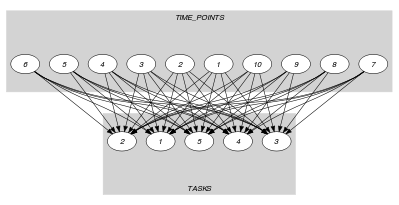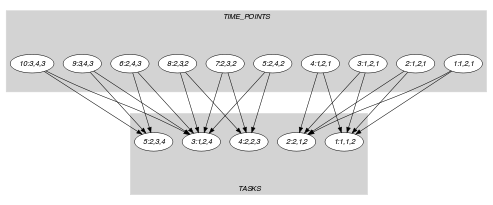5.402. track
| DESCRIPTION | LINKS | GRAPH |
- Origin
- Constraint
- Arguments
- Restrictions
- Purpose
The constraint forces that, at each point in time overlapped by at least one task, the number of distinct values of the attribute of the set of tasks that overlap that point, is equal to .
- Example
-
Figure 5.402.1 represents the tasks of the example: to the task of the collection corresponds a rectangle labelled by . The constraint holds since:
The first and second tasks both overlap instant 1 and have a respective trail of 1 and 2. This makes two distinct values for the trail attribute at instant 1.
The third and fourth tasks both overlap instant 2 and have a respective trail of 1 and 2. This makes two distinct values for the trail attribute at instant 2.
The third and fifth tasks both overlap instant 3 and have a respective trail of 1 and 2. This makes two distinct values for the trail attribute at instant 3.
Figure 5.402.1. The tasks associated with the example of the Example slot, at each instant we have two distinct values for the attribute ()

- Typical
- Symmetries
Items of are permutable.
All occurrences of two distinct values of can be swapped; all occurrences of a value of can be renamed to any unused value.
One and the same constant can be added to the and attributes of all items of .
- Reformulation
The constraint can be expressed in term of a set of reified constraints and of constraints:
For each pair of tasks of the collection we create a variable which is set to the attribute of task if task overlaps the origin attribute of task , and to the attribute of task otherwise:
If :
.
If :
.
-
For each task we impose the number of distinct trails associated with the tasks that overlap the origin of task ( overlaps its own origin) to be equal to :
For each pair of tasks of the collection we create a variable which is set to the attribute of task if task overlaps the end attribute of task , and to the attribute of task otherwise:
If :
.
If :
.
-
For each task we impose the number of distinct trails associated with the tasks that overlap the end of task ( overlaps its own end) to be equal to :
With respect to the Example slot we get the following conjunction of constraints:
The constraint corresponding to the attributes of the tasks that overlap the origin of the first task (i.e., instant 1) that has a trail of 1.
The constraint corresponding to the attributes of the tasks that overlap the origin of the second task (i.e., instant 1) that has a trail of 2.
The constraint corresponding to the attributes of the tasks that overlap the origin of the third task (i.e., instant 2) that has a trail of 1.
The constraint corresponding to the attributes of the tasks that overlap the origin of the fourth task (i.e., instant 2) that has a trail of 2.
The constraint corresponding to the attributes of the tasks that overlap the origin of the fifth task (i.e., instant 3) that has a trail of 2.
The constraint corresponding to the attributes of the tasks that overlap the last instant of the first task (i.e., instant 1) that has a trail of 1.
The constraint corresponding to the attributes of the tasks that overlap the last instant of the second task (i.e., instant 1) that has a trail of 2.
The constraint corresponding to the attributes of the tasks that overlap the last instant of the third task (i.e., instant 3) that has a trail of 1.
The constraint corresponding to the attributes of the tasks that overlap the last instant of the fourth task (i.e., instant 2) that has a trail of 2.
The constraint corresponding to the attributes of the tasks that overlap the last instant of the fifth task (i.e., instant 3) that has a trail of 2.
- See also
common keyword: (resource constraint).
- Keywords
characteristic of a constraint: derived collection.
constraint type: timetabling constraint, resource constraint, temporal constraint.
- Derived Collection
- Arc input(s)
- Arc generator
-
- Arc arity
- Arc constraint(s)
- Graph property(ies)
-
- Arc input(s)
- Arc generator
-
- Arc arity
- Arc constraint(s)
-
- Sets
-
- Constraint(s) on sets
- Graph model
Parts (A) and (B) of Figure 5.402.2 respectively show the initial and final graph of the second graph constraint of the Example slot.
Figure 5.402.2. Initial and final graph of the constraint

(a) 
(b) - Signature
Consider the first graph constraint. Since we use the arc generator on the collection, the maximum number of arcs of the final graph is equal to . Therefore we can rewrite to and simplify to .